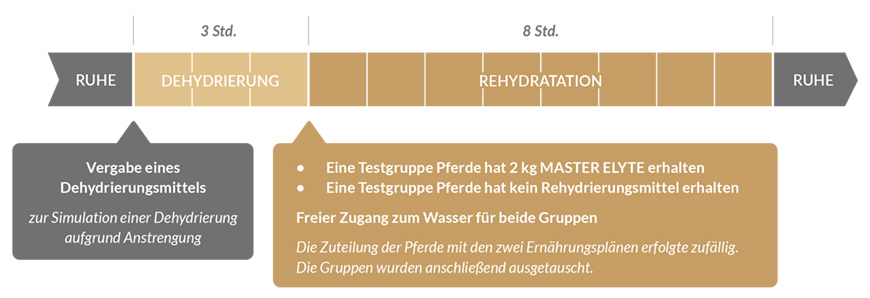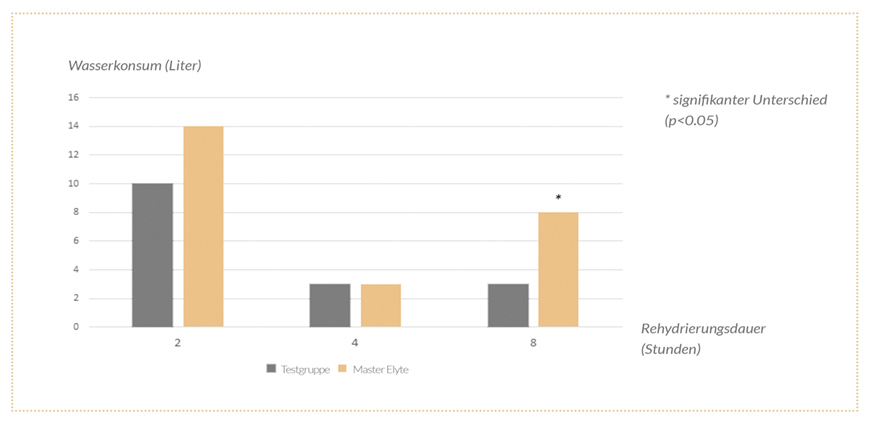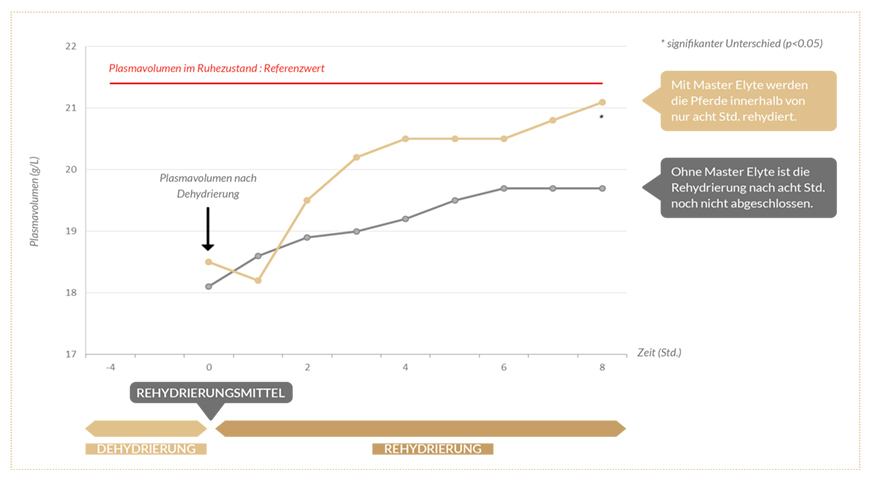Keine Artikel
Willkommen Lambey
Wählen Sie Ihr Land
Willkommen Lambey
Wählen Sie Ihr Land
Blog-Kategorien
Neueste Beiträge
Bei muskulärer Anstrengung erhöht sich die Körpertemperatur und der Mechanismus des Schwitzens, der zum Verlust von Elektrolyten führt, setzt ein.

Bei muskulärer Anstrengung erhöht sich die Körpertemperatur und der Mechanismus des Schwitzens, der zum Verlust von Elektrolyten führt, setzt ein.
Wir haben eine wissenschaftliche Studie zur Messung der Wirksamkeit des Rehydrierungsmittels Master Elyte durchgeführt, das in Form eines schmackhaften flockierten Nahrungsmittels verabreicht wird.
Es wurden Reitpferde bei leichter Arbeit mit einem durchschnittlichen Gewicht von 532 ± 50 kg ausgewählt.


| Dank dem Futtermittel Master Elyte haben die Pferde in den acht Stunden Rehydrierungsdauer etwa 10 Liter Wasser mehr getrunken. |

| Nach acht Stunden Rehydrierung ist die Wiedererlangung an Plasma-Elektrolyten bei Pferden, die das Futtermittel Master Elyte erhalten haben, bedeutend höher. |
Entwicklung des Plasmavolumens in der Zeit

|
Master Elyte hat es dehydrierten Pferden ermöglicht, ihren Plasmaspiegel im Ruhezustand innerhalb von acht Stunden wieder zu erreichen. |
Die Ergebnisse dieser Studie wurden von einem internationalen Expertengremium ausgewählt, um auf der CESMAS-Konferenz (Conference on Equine Sports Medicine and Science) in Oslo vorgestellt zu werden:
« Validation d’une forme innovante d’électrolytes pour faciliter la réhydratation des chevaux en effort intense. »
Validation of an innovating electrolytes form to facilitate rehydration in performance horses
Respondek F, Lambey JL, Drogoul C and Julliand V
Take home message
This study validated, under laboratory conditions, the efficiency of an innovating form of an electrolyte-enriched product in
rehydrating performance horses. This enriched feed was well consumed by horses, which represents a major advantage compared
to other electrolytes products.
Introduction
Rehydration after exercise represents a major element of the recovery process. This is why many riders or trainers provide
electrolytes to their horses after a race or an event. However, several of them claim that it is sometimes difficult to administrate
electrolytes to horses because of their bad taste. A syringe with electrolytes paste may sometimes increase the dehydration status if
horses are not in the mood for drinking. We performed a study to evaluate the efficacy of an electrolyte-enriched and highly
palatable feed to help horses to rehydrate after exercise and compared three different ways of rehydrating horses in the field.
Material and methods
Six saddle horses with an average body weight of 532± 50 kg were used. During the whole study, horses were kept in stalls, with
wood shaving for bedding. They were exercised twice a week and were turned out in a paddock on the other days. Given amounts of
pellets, hay and straw were calculated to cover the requirements of horses in light work. Dehydration of horses was induced by an
IM injection of furosemide (1mg/ kg BW, Dimazon 5%) to stimulate an exercise-induced dehydration, which was similar among horses
and trials (Rose et al. 1986; Sosa Leon et al. 1998; Monreal et al. 1999; Butydom et al. 2002). Rehydration treatments consisted in an
electrolyte-enriched feed, a soluble powder of electrolytes and a control treatment with no electrolytes offered. The experiment
was designed as a 3X3 latin square. Horses were offered the rehydration treatment three hours after the injection and had then
free access to fresh water. To be sure that horses having the powder treatment would consume it, it was given to horses with 6
liters of water by naso-oesophagus intubation. To induce the same stress status in all horses, each horse was intubated in each
trial. Rehydration of horses was kept track of for eight hours, by cheking body weight and voluntary consumption of water. Blood
samples allowed to determine total proteins as well as sodium, potassium and chloride contents in the plasma. In euhydrated status,
it has been estimated that plasma volume corresponds to 4% of the body weight of horses (Forro et al. 2002), and its variation has
been estimated with the measure of total proteins (Boyd 1981). Electrolyte concentrations in the plasma were multiplied by the
plasma volume in order to take into account its volume variations for the evaluation of electrolyte content variations. Results
were analyzed with the GLM procedure of SAS with repeated measures. An ANOVA with time as variable within each treatment was
also executed with a test of Dunnett, which was applied if a significant effect was detected.
Results
After eight hours of recovery, both electrolyte treatments allowed a significantly (p<0.05) higher consumption of water and better
recovery of weight by horses compared to the control treatment. Indeed, during this period, horses consumed around 10 liters
more with both electrolyte treatments compared to the control treatment.
Plasma volume and plasma electrolyte contents tended to increase during the recovery period. At the end, plasma volume was
significantly greater in horses receiving electrolytes than in horses receiving the control treatment. Moreover, at this time,
plasma volume from treated horses was no more different from the rest value. This was still the case for horses receiving the
control treatment. After eight hours, plasma chloride and sodium contents were significantly greater in horses receiving
electrolytes (p<0.005 for enriched feed and p < 0.10 for powder) than in horses receiving the control treatment. In horses receiving
the enriched feed as rehydrating treatment, after eight hours of rehydration, total plasma content of the three considered
minerals did not differ from resting values (p<0.005). This result was not observed with the two other treatments.
Conclusion
As expected, both electrolytes treatments provided a better recovery of plasma volume and electrolytes than the control
treatment. Thus the innovating form of electrolytes was efficient to improve horse rehydration. The results lead us to hypothesize
that for the considered minerals, chemical or botanical origin might affect their bioavailability more than their physical
presentation could do.
Address of authors
Respondek F and Lambey JL
Lambey SA, France
Drogoul C and Julliand V
Enesad, France
References
Boyd J (1981)
The relationship between blood haemoglobin concentration, packed cell volume and plasma protein concentration in dehydration.
Brit VET J 137: 166-172.
Botudom P, Schott H, Davis M, Kobe C, Nieslen B and Ebeerhart S (2002).
Drinking sat water enhances rehydration in horses dehydrated by frusemide administration and endurance exercise. Eq Vet J suppl
34: 513-518
Forro M, Cieslar S, Ecker G, Wolzak A, Hahn J and Lindinger M (2000)
Total body water and ECFV measured using bioelectrical impedance analysis and indicator dilution in horses. J Appl Phys 89: 663-671.
Monreal L, Garzon N, Espada Y, Ruiz-Fopegui R and Monedes J (1999)
Electrolyte versus glucose electrolyte isotonic solution for oral rehydration therapy in horses. Eq Vet L suppl 30: 425-429.
Rose R, Gibson K and Suann (1986)
An evaluation of an oral glucose-glycine electrolyte solution for the treatment of experimentally induced dehydration in the
horse. Vet Rec 22:522-525
Sosa Leon L, Hodgson D, Carlson G and Rose R (1998)
Effects of concentrated electrolytes administered via a paste on fluid, electrolyte, and acid base balance in horses. Am J Vet res
59:898-903.